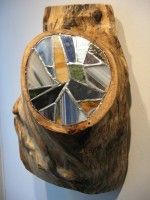Where the Art Is: Joel Koos

In Chenango County is the small town of Earlville and nested among the few shops that line main street is the Earlville Opera House, one of the most notable arts venues in a three-county region. Since 1970, the EOH has been a non-profit organization that features both musical and theatrical performances and visual art.
As the name would suggest, the EOH is located in a renovated Opera House, which dates back to 1892. Just as the early EOH had been the cultural center for theater and silent films, so too is the current organization a hub of artistic and community activity. With a regular schedule of theater performances, art classes, artist talks, gallery exhibitions and open mic nights, it is clear how the EOH has gained a reputation for being the preeminent multi-arts center in Central New York. As part of its gallery series, which typically includes both local and traveling artists, the EOH has recently opened an exhibit of New York City-based artist Joel Koos.
In this exhibit – “A World Without Us…” – Koos examines humanity’s precarious and often complex relationship to nature. The part of nature that interests Koos is not the picturesque or the majestic, but rather what he sees when “looking down.” As part of his larger body of work “Rebirth from Refuse,” Koos’ current exhibit at EOH is an assemblage of several pieces that, in the spirit of Rebirth, he has presented before. Although he mostly exhibits in Brooklyn and Manhattan, he has shown work in galleries as far reaching as Tempe, Arizona and Huntsville, Alaska.
If there is one trope that unites all bodies of work in this exhibition it is the found object. Whether he uses pine cones suspended in plastic spheres (Recomposition of a Pine Forest) or the discarded shards of glass that are nested in the knot of a birch tree (Cathedral of Birch) Koos finds a way to reshape and revitalize what others usually overlook. Koos, who holds a BFA from Stony Brook University and a MFA from Long Island University, has lived most of his life on the south shores of Long Island and draws inspiration from the forested landscape of his home. In his Symbiosis series, Koos looks to literally intertwine nature, art and sculpture. Symbiosis 4, for instance, consists of a split tree limb, which Koos has carved into patterned wood. It is lit from below and suspended from the wall, where there hangs a woodblock colored-print that Koos made from the same wood pieces.
Above both parts hangs a rare potted plant. In another work, Hydrophobicity, Koos displays a potted tree on the gallery wall and inserts a painting of a tree trunk (on homemade paper) into the center of the plant. His intention is for his own creation, the painting, to return to nature through reconciliation with the plant; the tree is meant to erode the paper, thus destroying the man-made object. Not only do these works seek to combine the manufactured artwork with the natural object, but they also serve to question how we devalue the natural world, which has become a manufactured place in itself. Koos carries out this critique of our precarious relationship to nature in Our Estranged Marriage. Consisting of hundreds of ring-boxes, filled with rocks instead of rings, then lined up in wave-like rows on the gallery floor, this work teasingly exemplifies our own precarious relationship to the environment, suggesting that we perhaps are not living up to our vows.
Above all, what makes Koos’ work profound is its quiet restraint. Though his subject matter can be considered political, his pieces are never angry. Nor are they loud. If there is a palpable emotion, it is sadness; but Koos balances this with a paradoxical sense of hopeful optimism. It is by creating this complicated reconnection to nature that Koos hopes to educate as well as intrigue the viewer. “My intention,” Koos writes, “is that they leave with the knowledge that humanity shares more of a union with the unprocessed part of the landscape.”






